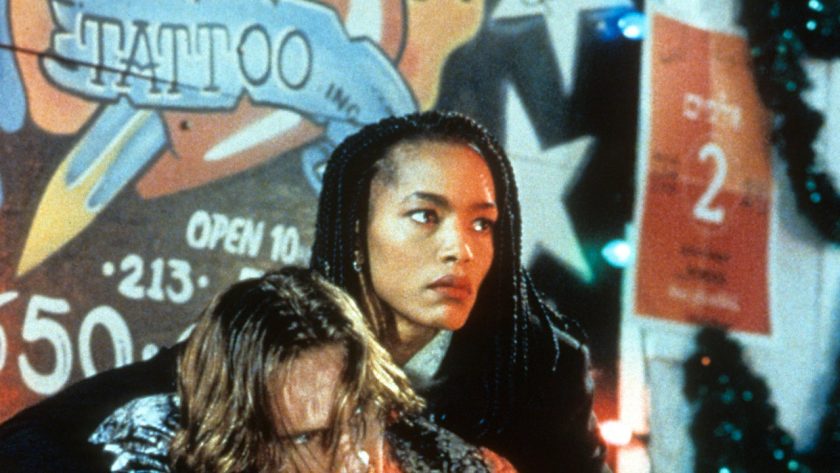Ask someone to name a New Year’s movie, and more than likely they’ll come back with either a great movie with a single extremely memorable New Year’s Eve scene, or a terrible one centered around the holiday itself. That’s all well and good, but if you’re in the mood for a post-Christmas movie that maintains the holiday spirit without necessarily reminding you of the other holidays that just ended, you don’t need to throw on Boogie Nights, Phantom Thread, When Harry Met Sally, or Diner (or anyway, you don’t need to use New Year’s as an excuse to watch or rewatch any of those). And rest assured: You never need to throw on New Year’s Eve or 200 Cigarettes, ever. There may not be a wealth of great New Year’s Eve movies, but there is a solid group of good New Year’s Eve movies from the past century or so. Rather than subjecting yourself to cacophonous musical performances (or a Garry Marshall ensemble comedy), consider ringing in the new year by time-traveling through this mix of classics and curiosities in which the holiday plays a central role. If you want to stay home on New Year’s Eve (or need something to watch from the couch the next day), one of these should do the trick.
After the Thin Man (1936)
The Thin Man, the first mystery-comedy featuring married semi-sleuths Nick and Norah Charles (William Powell and Myrna Loy), is set during the Christmas season, and one of the most delightful aspects of the sequel (the first of five featuring Powell and Loy) is that it heads straight into New Years; would that more Christmas-set entertainments saw fit to follow this trajectory. Now, is After the Thin Man as good as the original? No, it is not. This is one of those series where the first one is the one everyone loves most, for good reason. But it’s also one of those series where the opportunity to simply spend more time with its lead characters as they banter, bicker, and solve additional mysteries is still a welcome one, and seasonally celebratory; Nick and Norah are essentially hosting a New Year’s mystery party you’re not desperate to leave. Sadly, the series drops its holiday progression after this installment; maybe the further sequels would be better-regarded if they headed straight into Valentine’s Day, St. Patrick’s, and so on.
Holiday (1938)
Though the title refers to the plans Johnny Case (Cary Grant) has to take a much-deserved holiday after years of hard work, much of the pivotal action in this classic George Cukor-directed romantic dramedy takes place on New Year’s Eve. Over the course of the evening, Johnny finds himself increasingly drawn to the free-spirited Linda (Katharine Hepburn), the older sister of his fiancée – and during the lavish engagement party thrown by his business-minded future father-in-law, no less. Imbued with Cukor’s graceful touch along with Grant and Hepburn’s undeniable chemistry, Holiday is essentially a New Year’s resolution movie, with the heartening twist that Johnny is attempting to keep a promise of passion, freedom, and leisure, rather than hold himself to an exacting standard of capitalistic self-improvement.
Repeat Performance (1947)
As a recent Criterion Channel series illustrated, there are plenty of noirs and noir-adjacent thrillers set around Christmas. There are fewer that revolve around New Year’s Eve—and fewer still that use the holiday as an excuse for a thematically resonant fantastical do-over. Sheila Page (Joan Leslie) literally jumps the gun on the new year, as the movie opens with her standing over her slain husband with a smoking pistol in her hand. (Regrets, she has a few.) But on the morning of January 1st, she wakes up a full year earlier—husband alive, mistakes unmade, second chance magically granted. The movie follows her attempts to steer her life away from murder, raising questions about fate, the universe, and whether we’re doomed to repeat our worst impulses. For extra metatexual zing, Leslie’s character is an actress – but when dealing with what feels like fate, aren’t we all?
Ocean’s 11 (1960)
Look, let’s be real: the Soderbergh-Clooney version of Ocean’s 11 is better. A lot better; one of the best of its kind. But the Rat Pack version with Frank Sinatra, Dean Martin, and Sammy Davis Jr. (among others) is the one that actually places its heist on New Year’s Eve, which is admittedly an inspired idea. Even better, the arc of this earlier crack at this material is undoubtedly New Year’s-coded: You start off excited to see a bunch of familiar faces, start to get bored and wonder if you’ve arrived too early as the party meanders through its early stages, get more excited and engaged once the clock inches closer to midnight and everything starts to feel livelier, and feel a bit of a letdown in the aftermath as the evening amounts to a long set-up with a modestly amusing punchline.
More American Graffiti (1979)
Did you know there was a sequel to George Lucas’s seminal 1973 film American Graffiti, and that it shares a title with a second volume of the original film’s soundtrack? Though it’s not nearly as great as the original (which is mainly to say it’s not one of the best movies of the 1970s), More American Graffiti does come up with an ingeniously overelaborate solution to following up an ensemble one-eventful-night narrative. Rather than reuniting all the characters who, as the previous movie’s final moments indicated, were unlikely to all see each other in the same place at the same time again, the sequel has four different storylines, each taking place on a successive New Year’s Eve in 1964, 1965, 1966, and 1967, intercut but easily legible thanks to the different characters and styles for each time period. The way the story splits off into dark war farce, semi-miserable domestic drama, and youth-culture chronicle perfectly captures the divergent (and, yes, sometimes disappointing) paths the characters find themselves on. Of course the movie must turn to New Year’s; as adults, the characters can no longer rely on school years and those attendant rituals to mark the passage of time. More diffuse by design, American Graffiti can’t be as powerful as its predecessor, but as a holiday-themed follow-up, it’s a fascinating experiment.
New Year’s Evil (1980)
The post-Halloween slasher boom provided two New Year’s-themed horror movies in 1980. Terror Train is the more traditional entry: Masked killer, young people getting offed at a prodigious rate, Jamie Lee Curtis, with the bonus of a Agatha Christie-ish gimmick: most of the action takes place on a moving train. But there was a better train-themed New Year’s movie coming down the track. 1980’s quickie oddity New Year’s Evil—which started shooting in mid-October and came out in time for the titular holiday two months later!—wins the token holiday-themed slasher spot. Though the killer eventually, halfheartedly dons a creepy mask (a caricature of Stan Laurel, no less!), much of the movie is an unusual hybrid of ridiculous-gimmick slasher (a killer picks off victims one by one, timed to New Year’s celebrations across time zones), and serial-killer thriller, where we see the guy’s face from the jump. The de facto final girl is a glamorous DJ (Roz Kelly) hosting a live countdown show all evening, ringing in the year from coast to coast as bands described by the movie as “punk” and “new wave” play. (The two real-life bands on display, Shadow and Made in Japan, are more pop-metal and power-pop, respectively.) The live footage and accompanying neon lighting gives this 86-minute movie an extra jolt of novelty; it’s not exactly terrifying, but it’s entertaining perverse and has genuine holiday atmosphere, giving a Dick Clark-style TV broadcast a menacing, purgatorial feel that now doubles as a time capsule. Also and relatedly, the theme song by Shadow rips.
Ghostbusters II (1989)
It’s nowhere near as good as the first Ghostbusters; the cast feels like they’re cheerfully going along, rather than enthusiastically inspired, the story engages in some lazy resetting before getting the group together, and the tone feels more oriented toward the surprising number of young fans the first movie picked up. Yet that last bit also makes this sequel a strong New Year’s choice for families, especially considering that the plot revolves around a river of pink slime underneath New York City that feeds off of bad vibes and negativity. Is it a little corny that the Ghostbusters rally the dyspeptic citizenry to their cause by animating the Statue of Liberty with “positively charged” slime and using it as a vehicle for engendering feelings of togetherness? No—it’s extremely corny. But it’s also a zany, amusing alternative to the pure hell people must experience watching the ball drop in Times Square.
Metropolitan (1990)
What lesser New Year’s Eve movies like New Year’s Eve and 200 Cigarettes get wrong is their understandable insistence on packing as much one-crazy-night action as possible into 24 hours or so; what Whit Stillman’s Metropolitan gets right is how the whole last week of the year, when schools are often out and offices often closed, can feel like a melancholy culmination of something, even if we’re not exactly sure what. That’s especially true for young people on some kind of in-between break, and Stillman’s film is one of the great young-people-on-break movies (an admittedly niche subgenre), wherein a group of mostly upper-class college-aged friends attend deb balls and after-parties during (but not necessarily of) the holiday season. They pontificate and posture as befits their social status, while possibly starting to realize an inkling of the world outside that youthful bubble, and the myriad opportunities for failure and disappointment that await there. Like Stillman’s terrific Last Days of Disco, it’s about existing in a season of parties and starting to see the end of it on the horizon.
Peter’s Friends (1992)
Peter’s Friends is essentially a British Big Chill where the reunion takes place on a New Year’s weekend rather than forced by tragedy – though there is a dash of the tragic in this dramedy co-written by comedian Rita Rudner (who also has a supporting role as a famous spouse on the outside of the semi-estranged friend group). It’s easy to see why it feels less zeitgeisty than Big Chill did in its day; the latter’s 15-year gap between college in 1968 and reuniting in 1983 feels a lot more eventful than Peter’s trip from 1982, when the friends are working together in some kind of insufferable performance troupe, to their 1992 adulthood (though the super-familiar soundtrack cuts are at least less musty today than some of those Big Chill needle drops). What makes the movie memorable, and a worthwhile evocation of the holiday, is how director Kenneth Branagh (who also plays one of the friends) captures the simultaneous chumminess and rancor of longtime friends, particularly those with a flair for the dramatic. At the center is a lovely, understated performance from Stephen Fry as Peter, a privileged young man who has reached a crossroads seemingly by accident, for reasons that become more clear as the movie goes on. If you’re missing your old school chums on New Year’s, Peter’s Friends can offer some surrogates, or maybe remind you of what a headache those group dynamics can be.
Strange Days (1995)
One of director Kathryn Bigelow’s best – and, in its initial release, most slept-on – features, Strange Days takes place during the last few days of 1999, generating a turn-of-millennium tension that became more subtextual during actual movies from 1999; maybe Y2K rattled enough real-life nerves to cause filmmakers to back off. Strange Days, co-scripted by James Cameron, certainly doesn’t back off, at least for most of its running time: It folds in police brutality and digitally augmented living in a way that felt like slamming a bunch of hot buttons back in ’95, and has circled back around to feeling contemporary again decades later. Lenny (Ralph Fiennes), a slickster dirtbag, peddles illegal memory recordings designed to let people live through other people’s experiences, with all of the sleaze, thrills, violence, and sadness that entails; it’s like a chilling solution to Instagram FOMO that someone at Facebook is probably working to recreate at this very instant. When one of Lenny’s memory discs turns out to contain evidence of a murder, he and his longtime gal pal Mace (Angela Bassett) are drawn into a dangerous conspiracy. If you tend to experience the passage of another year as if you’re on the precipice of disaster, Strange Days is jittery and paranoid enough to give you a fix, but not so dark (maybe even, in the end, a little too squishy) to fry your brain.
Four Rooms (1995)
Once regarded as a massive disappointment in the way that only “Quentin Tarantino’s directorial follow-up to Pulp Fiction” could, the fullness of time has revealed Four Rooms as an uneven novelty—also known as an anthology film, a format that gets a bad rap for its inability to produce flawless gems. But flawless is clearly not what the eclectic Four Rooms is going for as it offers a quartet of entertaining stories taking place at the same hotel on New Year’s Eve, all involving the green and overtaxed bellman Ted (Tim Roth). Allison Anders, Alexandre Rockwell, Robert Rodriguez, and Tarantino each take a go at torturing poor Ted, and though the results are uneven, the segments are brisk and amusing enough to make the whole thing worthwhile as a tour through other people’s leisure time. The slapsticky Rodriguez segment “The Misbehavers” clearly prefigured his Spy Kids series, and Tarantino’s “The Man from Hollywood,” a riff on an old Alfred Hitchcock Presents episodes, is the perfect seedy post-fame hangover/hangout for the pre-dawn hours.
Highball (1998)
Noah Baumbach would not put this movie on this list. Noah Baumbach would, by all indications, prefer that this movie did not exist; it was made with leftover time and money from his second film Mr. Jealousy, and according to the filmmaker, it wasn’t really properly finished—a failed experiment that was released to the home-video market with Baumbach’s name pseudonymously removed from the writing and directing credits (though amusingly, he remains properly credited as an actor; yes, like Tarantino, he appears in his own film here, and he’s very funny.) But you should not listen to Noah Baumbach on this particular matter, because Highball is up there with Mistress America and Kicking and Screaming as one of his flat-out funniest movies, a more purely comic gloss on his typically sharp explorations of social niceties and relationship dynamics. The whole thing doesn’t actually unfold on New Year’s; that’s the final segment in a triptych of party sequences with the same loose friend group (including Metropolitan’s Chris Eigeman!) gathering at the same Brooklyn apartment: a birthday party, a Halloween bash, and the New Year’s event, with a variety of relationships ebbing and flowing both at the parties and offscreen in between them. The birthday party is the most grounded in elegantly wrought cringe comedy, based around the presence of Felix (Carlos Jacott), an asshole who Travis (Christopher Reed) considers his best friend in a way that is both inexplicable and familiar. The Halloween party is the funniest, with a lot of costume-based shenanigans (including Baumbach accidentally dressing like Hitler). But the weird, uncomfortable soul of the movie is the New Year’s segment, where the characters’ regret and confusion really takes shape.
Snowpiercer (2013)
Aren’t holidays like New Year’s just social constructions, anyway? If you want to take a deconstructionist approach to the holiday, consider Bong Joon-ho’s sci-fi thriller Snowpiercer, which (like New Year’s non-classic Terror Train) takes place mostly on a moving train. In the aftermath of a new ice-age apocalypse, remaining humans are packed (or, if you’re wealthy, comfortably spaced out) onto a massive 10-mile train, which circumnavigates the iced-over globe in an endless loop. To celebrate their trip around the planet, train denizens perform a New Year’s countdown every time it passes a landmark bridge – which is more often than the typical 365-day calendar, but when the whole planet is covered in ice and snow, what’s the difference? If you want to chase your pessimism with just the faintest glimmer of hope about the dawning of a new year, while acknowledging how arbitrary that specific marker may be, just hop aboard the Snowpiercer train.



